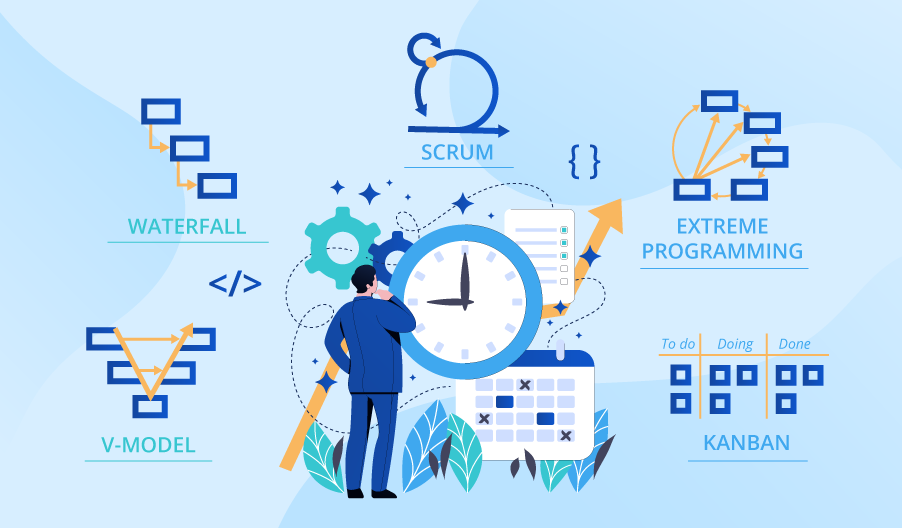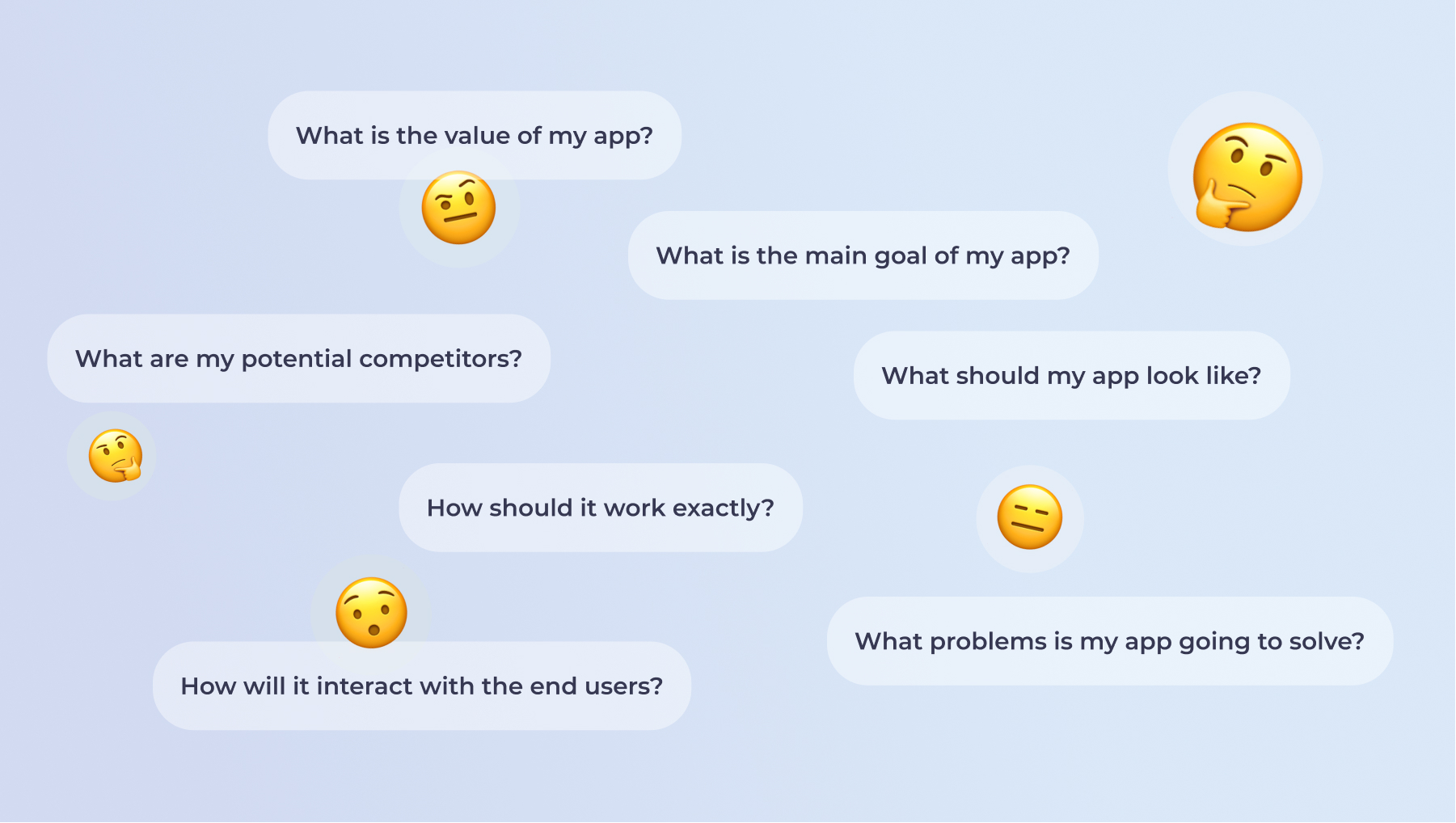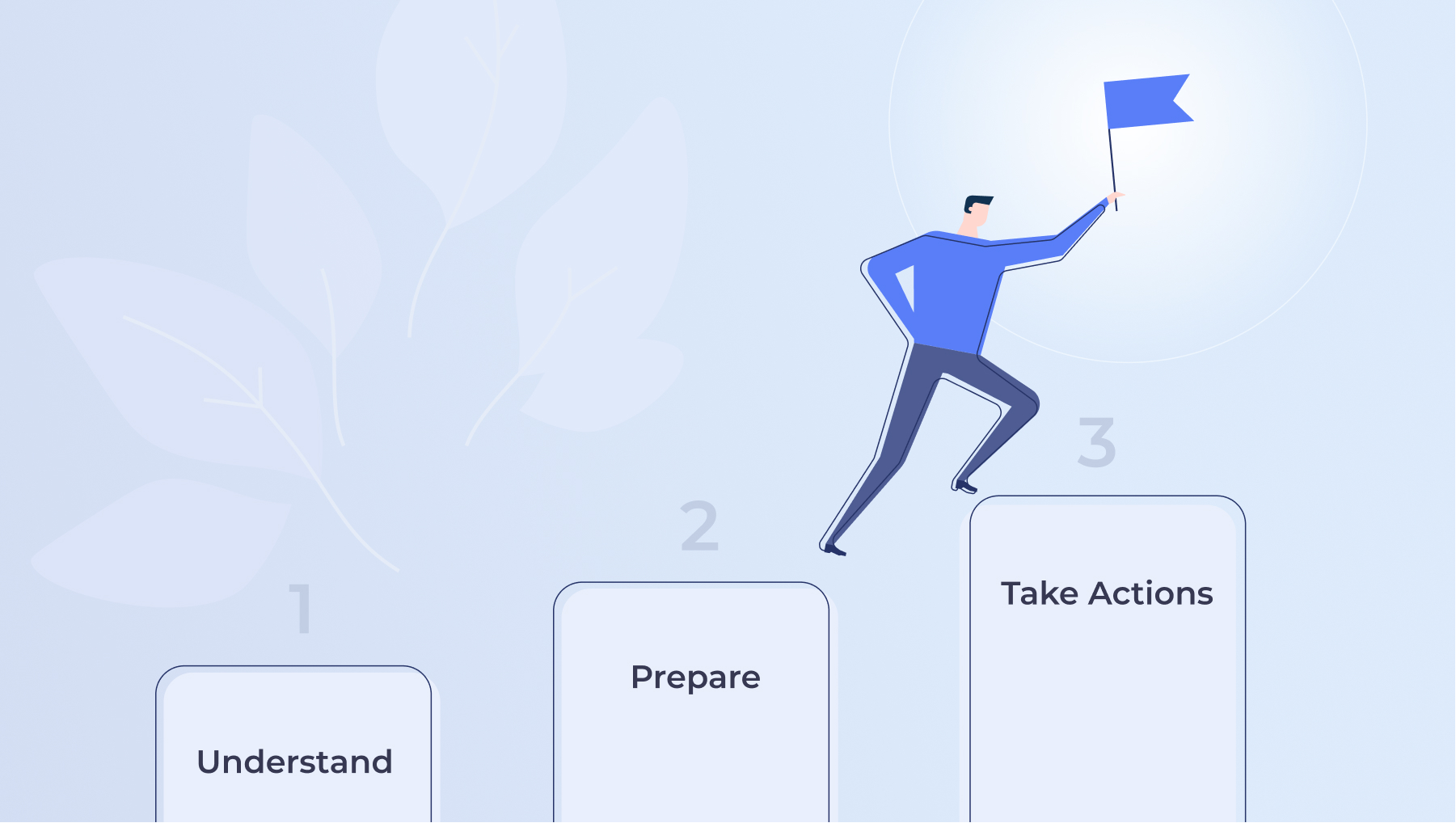Table of Contents
Building an application is a responsible step (after all, you will invest a great deal of time and resources in your projects). And believe us, everything starts not with design prototyping or coding. The first thing you will need to do is spend some time researching the market and shaping your app idea.
Whether you are at the stage of raising investment to your project or are 100% ready to start requesting the estimations from the development team, you will have to provide the most relevant information about your app idea. This will allow you to get adequate financing from investors and accurate estimates from the developers.
In one of our articles, we described how companies estimate total project development cost, but what we have left unsaid was the To-Dos you have to complete. And we’ve missed this aspect on purpose since this is the topic that requires a separate blog post.
Today we are going to share with you some tips that will help you with the pre-development preparation. We will also tell you about the crucial questions you should ask yourself before reaching out to the development team and shed light on the crucial aspects you need to take into account during the initial research phase. So, without further ado, let’s get started.
In-depth market research is a must
Before contacting any software development agency and requesting your project estimation, you should think about the purpose of your app. Why is that necessary? First of all, you know your business and its challenges better. Second of all, you might have some expectations about your future app. And developers cannot just guess what those expectations are, they need more or less clear information to get started.
So what should you ask yourself to define the purpose and value of your future solutions? Basically, it’s a set of questions that will help you dig deeper and uncover all the necessary details. Here are these questions:
Once you have more or less established answers to these questions, you can proceed with other preparations and further competitor research. It is obvious that large startups and businesses of different sizes will require different kinds of research.
What kind of research do large startups need?
It is not easy for a startup to successfully enter the market, considering tough competition and a variety of diverse solutions. Therefore, to find your unique competitive advantage, you should search for as much information about your competitors as possible.
Let’s say your app offers a new solution to user problems. However, there are many other apps that resolve those problems in a good old way. To poach their users, attract new ones and encourage them to use your particular solution, you need to know all of the advantages and disadvantages of your competitors.
This knowledge will let you find the strength of your particular business, create a different approach, select the right monetization option and develop a solution that stands out. Speaking about the competitors, you should know that they are divided into two main groups:
By exploring both competitor types, you will get a bigger picture that will help you define your project value, uniqueness, and must-have feature set. We will discuss these things a little bit later, so keep reading.
And now, let’s talk a little bit about monetization. The end goal of any startup is to attract numerous users and bring profit to its owner. So you should definitely discover what monetization options can be applied to your particular solution beforehand.
There are numerous ways of monetization that can perfectly work for you. Among them, you can consider the following and develop either a fully paid app (which is quite risky) or an app with:
- In-app purchases option;
- Subscription plan;
- Premium features;
- Advertising option.
What kind of research can businesses make use of?
When it comes to businesses, they are not looking for a way to enter the market. They are instead trying to find out how to optimize their processes thanks to digitalization and custom software development. And this approach requires a little bit of different research.
There are several reasons why businesses consider custom development. Some might not be satisfied with the ready-made solutions that lack customization and flexibility. Others need more complex solutions than they already have. And there are also companies which are interested in developing SaaS solutions for internal and external use. Either way, custom development requires research.
To begin with, you need to define clearly your current business challenges and solutions used to solve them. Then it is necessary to explore the market of similar available solutions to check what feature set they have and what client problems they solve. Once it is done, you will get a more or less prepared functionality list that can come in handy for your own custom solution.
Also, you need to think thoroughly about the overall digital experience in your company and think if anything requires improvements. This will also help you understand whether your new solution will need to be connected with other ones already used in your company. Or maybe you will even end up refusing old but gold solutions and consider creating one complex feature-rich software for multiple purposes. That is exactly what the pre-development research is for – to help you find out what, how and where new solutions can improve.
Custom solutions for businesses require a personalized approach as they should be totally adapted to certain business processes of a specific company. That is why pre-development research for businesses also demands deep immersion into the business environment;to create a highly functional solution, you need to think about the end user and the business process that is going to be automated. And it is possible to consider these factors only when you understand the specifics of a particular business.
By now you may be intimidated by the amount of work that should be completed during the pre-development stage. But don’t worry, the research can be successfully delegated to your software development partner.
For example, let’s take our company. Here at Altamira, we perform a Discovery stage for each project and do a holistic research taking into account the specifics of our client’s business.
Although the research can be delegated, you need to remember that you are the one who knows your startup or business goals and abilities better than anyone else. So you need to stay involved and cooperate with the development company (and Business Analysts, in particular) before and during the research. It is preferable to provide all requested information, as it will allow you to get the best and most relevant research results.
Define your value proposition
After discovering their main competitors and getting detailed information about their solutions, it’s time to define a value proposition. The same should be done by businesses which are going to develop SaaS and custom BI tools.
First of all, let’s define the value proposition. Basically, it is a concept that outlines all benefits of your particular solution and summarizes why users will appreciate using it. Value proposition outlines the key productivity issues and, at the same time, it demonstrates how the solution is able to resolve core user’s problems and which user’s routine tasks can be automated partially or in whole.
Here is what you need to think about while defining your value proposition:
- Main problems all your users might face or deal with at the moment.
- Ways your solution can eliminate those issues and automate routine operations.
- The real value your solution will create for all end users and business, in general.
Your application should positively affect user experience, and you should be able to make them realize your solution’s value. For startups and companies launching SaaS platforms, the value proposition means a lot. And here is why – have your users understood that your solution is a much-needed tool,you can convert them into regular users and potential customers.
So before contacting any development company, you should be prepared to provide the following information to them:
- The end-user profile (detailed information about your potential users,e.g., their age, job position, professional habits, goals, challenges and pain points, etc.);
- Your value proposition (all possible benefits of your future solution and what will make it one of a kind);
- The main pains (the problems your solution is going to eliminate or the aspects of work it is going to automate and, therefore, improve).
Think about specific requirements
Before initiating software development, it is essential to think about some specific requirements – functionality, goals, and some future operational principles.. Well-thought-out, specific requirements will help your Project Manager and developers separate bugs from the actual functionality which can save you costs, time and nerves.
To help you define your specific software requirements, we have prepared a short list of crucial questions. Just check them out and try to answer them as fully as possible.
- What major problems should your solution resolve, and what areas of business should it optimize?
- How do your potential end users manage to resolve those problems now, without any software at all (or with ready-made solutions)?
- In what way will your software resolve those problems?
- What obvious and non-obvious benefits will it bring (e.g., it can save time, reduce costs, speed up customer service or optimize this or that working process)?
Your final product will definitely offer users a full set of useful features. But before developers can start their work, they should understand the complexity of each feature and estimate the development time.
You will pay an hourly rate for development services. So it is very important to provide a company with precise information, so that they can estimate the scope of work accurately. You should think about your solution features beforehand and point out as many important details as possible. If it is going to be a specific custom feature, make sure you describe it clearly.
Let’s take a simple example to explain why it is really important to pay attention to specific requirements. For example, you may want to develop a solution for internal use and need to integrate a messenger into it. On the one hand, it may be a simple, quite basic messenger, the development of which will take up to 100 hours.
On the other hand, you may want a more advanced solution (like Facebook’s Messenger) that will allow your users to perform additional operations like money transfers or real-time support (chatbots). The development of such solutions will take way more than 100 working hours. Therefore, the workload will be doubled and so will the price.
Always keep this example in mind and provide as many details as you can about the desired app features to the company you’ve chosen to develop your solution. This will help you to avoid additional costs and numerous misunderstandings during the development process.
Sometimes, the clients of development companies can get confused when they hear the final cost of their application after the estimation is finished. The sum may exceed the expectations. However, there is no need to give up your idea or to search for freelancers or some other companies offering low-quality but affordable solutions.
You can discuss your project further with your development partner, see what features can be slightly changed or added in further releases, and in such a way preserve your app idea and functionality and yet reduce your expenses a bit. It’s all about prioritization, and that’s exactly what specific requirements are for. So don’t neglect them and your project will be exactly what you wanted.
How Altamira can help you
As we’ve mentioned earlier, Altamira always helps clients to complete holistic research and formulate the correct software requirements and goals. And now we’d like to provide a little bit more detail about the pre-development phase called Discovery stage and what advantages it can bring you.
To begin with, let’s speak about how the Discovery stage starts. First of all, a client needs to contact us and describe the idea of the future solution. Then we start shaping and polishing it. The main person who participates in idea shaping is our Business Analyst. Like any other research, the Discovery phase includes several key stages:
After each stage you receive a certain technical document that will help you with further solution development. After the Discovery phase, you will get – Project Vision document, Preliminary Specifications, Technical Vision Document, Project Roadmap, and last but not least the Design Concept of your future project.
The obvious benefits of holistic research are better project flexibility, minimization of development risks, clear and transparent development cost, and correct selection of project functionality and tech stack. So in other words by spending time on research, you are investing it in the success of your future project. We could not emphasize enough how important it is to never skip the pre-development stage and spend enough time on thorough project planning.
Thanks to the research, you will discover all of the pitfalls that can be related to the technical part of the project. On top of that, you will validate your idea, selection of features, compliance with necessary industry standards and regulations. And this, in turn, will let you estimate the project properly and not to overpay for it in the end.
FAQ
To sum it up
If you are going to ask a development company to make estimations for your project, you’d better come prepared. So first of all, define your business goals, your target audience, and the value proposition of your future app. Should you follow our recommendations from this article, you will have the most accurate estimate.
The development of your application can be cost- and time-effective if you provide the company with the most relevant information about your business and a future project. It is possible to assign the best developers with the relevant experience only if you describe in detail your vision and, most importantly, your end goal.






